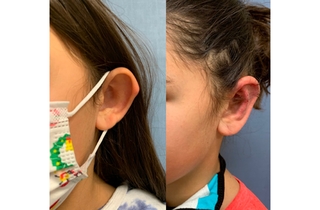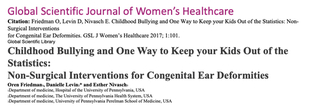
Cassandra A. Ligh, MD, FACS, is an expert plastic surgeon and reconstructive microsurgeon at Children’s Hospital of Philadelphia (CHOP). As a member of CHOP’s Ear Deformities Program, Dr. Ligh has a particular interest in ear reconstruction, including otoplasty (ear surgery).
Below, Dr. Ligh answers some of the most frequently asked questions from parents or caregivers of young children with ear deformities about otoplasty, such as its benefits, timing, potential risks and impact on daily life.
General questions about otoplasty
What is otoplasty and how can it help my child?
Otoplasty is surgery that improves the projection (how far the ear sticks out from the head), definition (detail) and overall appearance of an ear by giving it a more natural shape. Otoplasty does not affect your child’s hearing.
At what age is otoplasty recommended for children?
We recommend otoplasty for children above the age of 5 — when they can comply with the surgical dressings and activity restrictions and when the ears are at or near full size.
What types of ear deformities can otoplasty correct?
The most common types of ear deformities we see at CHOP for otoplasty are as follows:
- Protruding ears: also known as prominent ears, or ears that “stick out”
- Constricted ears : where the ear can appear constricted all the way around the ear (the affected ear is often smaller overall)
- Stahl’s ear: also known as an “elf ear” or “spock ear”
- Cryptotia: where the upper ear is buried beneath the skin
- Lop or cup ear: where the upper ear is folded over
- Helical rim deformity: where the outer rim of the ear can have pleating, folding, peaking or irregularity

Is my child a good candidate for otoplasty?
Children around 5 years of age or older with an abnormal ear shape, projection or definition may be good candidates for otoplasty. Our multidisciplinary team, which includes pediatric plastic and reconstructive surgeons and psychologists, will assess your child’s concerns, emotional stability and overall readiness for surgery. The surgeon will discuss what surgery they recommend, postoperative care, dressings and activity restrictions. The psychologist provides tools and resources to patients and families to both educate and support them through their surgical journey.
Procedure and safety
How is otoplasty performed?
Otoplasty is typically performed in the operating room under general anesthesia. An incision is made behind the ear within a natural crease to minimize visible scarring. The surgeon will reshape the ear using a combination of techniques that can include permanent suturing (stitching), cartilage removal, cartilage weakening or cartilage grafts, if more cartilage is needed. The type of techniques offered depends on the individual type of deformity.
Every ear is unique, and our team chooses an approach that best reflects your child’s needs. Some children may need more skin removed, while others might have a small amount of cartilage removed and stitched to de-project, or “pin the ears back,” so they stick out less. At the end, the surgeon closes the incision with stitches and applies a protective dressing (bandage) or headband.
Is otoplasty safe for young children?
Yes. Otoplasty is generally a safe, low-risk procedure, although complication can occur with any surgery. If you have concerns, please discuss them with the surgical team right away.
Although rare, the potential complications of otoplasty are as follows: heavy scarring, pain at the incision site, temporary swelling and bruising, continued ear asymmetry, recurrence or relapse, overcorrection or under-correction, changes in sensation, and blood collection under the skin (hematoma) that may need drainage.
Recovery and post-operative care
What kind of follow-up care is required/recommended?
During the first week post-surgery, we will schedule your child for a clinic visit to remove their protective dressing or headband. It is essential that your child limits their physical activity to walking or reading, for example, avoiding strenuous activities like running or jumping while they continue to heal. We recommend keeping the head slightly elevated whenever possible and taking any prescribed or over-the-counter medications to manage pain or discomfort. The surgeon may recommend wearing a headband at night for an extended period of time to allow the ear(s) to heal.
How soon can my child return to school or resume sports?
Most children can return to school within a week of surgery, with or without their dressing/headband, though it may take up to 2 weeks for any swelling to fully subside. They may resume non-contact sports at 4 to 6 weeks post-surgery; and contact sports, such as football, basketball or wrestling, at 6 to 8 weeks post-surgery.
Psychological and social concerns
Can otoplasty benefit my child's confidence and self-esteem?
Yes. Several studies have shown a positive impact on children’s happiness and self-esteem after otoplasty. One University of Pennsylvania study found that after having otoplasty, 97% of children felt happier and 92% felt more confident. 100% of those children reported a decrease in bullying or teasing.
Having an appearance difference can create many challenges for children, as it is often linked to their identity. Our Psychosocial Support Services team, which includes psychologists and social workers, is here to help your entire family navigate these challenges. They also help children process concerns about changes in appearance and identity before and after surgery.

When is the best time to consider otoplasty?
Children who willingly accept and cooperate with treatment, including post-operative care and activity restrictions, tend to have the best outcomes. For this reason, it is best to wait until your child is at an age where they begin to notice their differences compared to peers (usually around 4 or 5 years old). When the time comes, you can address those concerns by talking to your child about ear surgery as an option. It’s never too early to prepare for that conversation by educating yourself about otoplasty in advance.
Featured in this article
Experts
Specialties & Programs

Cassandra A. Ligh, MD, FACS, is an expert plastic surgeon and reconstructive microsurgeon at Children’s Hospital of Philadelphia (CHOP). As a member of CHOP’s Ear Deformities Program, Dr. Ligh has a particular interest in ear reconstruction, including otoplasty (ear surgery).
Below, Dr. Ligh answers some of the most frequently asked questions from parents or caregivers of young children with ear deformities about otoplasty, such as its benefits, timing, potential risks and impact on daily life.
General questions about otoplasty
What is otoplasty and how can it help my child?
Otoplasty is surgery that improves the projection (how far the ear sticks out from the head), definition (detail) and overall appearance of an ear by giving it a more natural shape. Otoplasty does not affect your child’s hearing.
At what age is otoplasty recommended for children?
We recommend otoplasty for children above the age of 5 — when they can comply with the surgical dressings and activity restrictions and when the ears are at or near full size.
What types of ear deformities can otoplasty correct?
The most common types of ear deformities we see at CHOP for otoplasty are as follows:
- Protruding ears: also known as prominent ears, or ears that “stick out”
- Constricted ears : where the ear can appear constricted all the way around the ear (the affected ear is often smaller overall)
- Stahl’s ear: also known as an “elf ear” or “spock ear”
- Cryptotia: where the upper ear is buried beneath the skin
- Lop or cup ear: where the upper ear is folded over
- Helical rim deformity: where the outer rim of the ear can have pleating, folding, peaking or irregularity

Is my child a good candidate for otoplasty?
Children around 5 years of age or older with an abnormal ear shape, projection or definition may be good candidates for otoplasty. Our multidisciplinary team, which includes pediatric plastic and reconstructive surgeons and psychologists, will assess your child’s concerns, emotional stability and overall readiness for surgery. The surgeon will discuss what surgery they recommend, postoperative care, dressings and activity restrictions. The psychologist provides tools and resources to patients and families to both educate and support them through their surgical journey.
Procedure and safety
How is otoplasty performed?
Otoplasty is typically performed in the operating room under general anesthesia. An incision is made behind the ear within a natural crease to minimize visible scarring. The surgeon will reshape the ear using a combination of techniques that can include permanent suturing (stitching), cartilage removal, cartilage weakening or cartilage grafts, if more cartilage is needed. The type of techniques offered depends on the individual type of deformity.
Every ear is unique, and our team chooses an approach that best reflects your child’s needs. Some children may need more skin removed, while others might have a small amount of cartilage removed and stitched to de-project, or “pin the ears back,” so they stick out less. At the end, the surgeon closes the incision with stitches and applies a protective dressing (bandage) or headband.
Is otoplasty safe for young children?
Yes. Otoplasty is generally a safe, low-risk procedure, although complication can occur with any surgery. If you have concerns, please discuss them with the surgical team right away.
Although rare, the potential complications of otoplasty are as follows: heavy scarring, pain at the incision site, temporary swelling and bruising, continued ear asymmetry, recurrence or relapse, overcorrection or under-correction, changes in sensation, and blood collection under the skin (hematoma) that may need drainage.
Recovery and post-operative care
What kind of follow-up care is required/recommended?
During the first week post-surgery, we will schedule your child for a clinic visit to remove their protective dressing or headband. It is essential that your child limits their physical activity to walking or reading, for example, avoiding strenuous activities like running or jumping while they continue to heal. We recommend keeping the head slightly elevated whenever possible and taking any prescribed or over-the-counter medications to manage pain or discomfort. The surgeon may recommend wearing a headband at night for an extended period of time to allow the ear(s) to heal.
How soon can my child return to school or resume sports?
Most children can return to school within a week of surgery, with or without their dressing/headband, though it may take up to 2 weeks for any swelling to fully subside. They may resume non-contact sports at 4 to 6 weeks post-surgery; and contact sports, such as football, basketball or wrestling, at 6 to 8 weeks post-surgery.
Psychological and social concerns
Can otoplasty benefit my child's confidence and self-esteem?
Yes. Several studies have shown a positive impact on children’s happiness and self-esteem after otoplasty. One University of Pennsylvania study found that after having otoplasty, 97% of children felt happier and 92% felt more confident. 100% of those children reported a decrease in bullying or teasing.
Having an appearance difference can create many challenges for children, as it is often linked to their identity. Our Psychosocial Support Services team, which includes psychologists and social workers, is here to help your entire family navigate these challenges. They also help children process concerns about changes in appearance and identity before and after surgery.

When is the best time to consider otoplasty?
Children who willingly accept and cooperate with treatment, including post-operative care and activity restrictions, tend to have the best outcomes. For this reason, it is best to wait until your child is at an age where they begin to notice their differences compared to peers (usually around 4 or 5 years old). When the time comes, you can address those concerns by talking to your child about ear surgery as an option. It’s never too early to prepare for that conversation by educating yourself about otoplasty in advance.

Contact us for a second opinion
Our team is available to consult with you or your physician on second opinion requests. We work with families and physicians from all over the country and around the world to confirm diagnoses and provide second opinions on treatment recommendations so you can make informed decisions.
Contact us
Ear Deformities Program